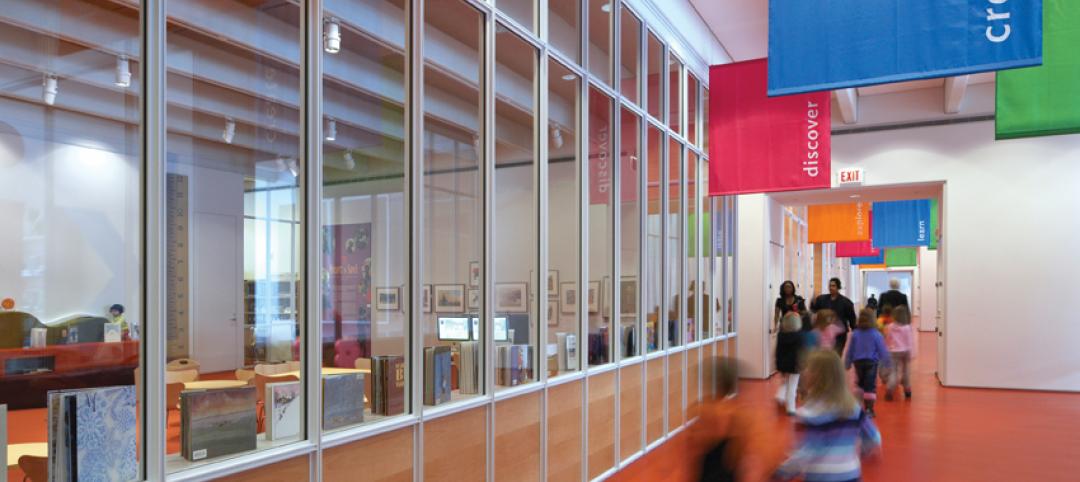Schaumburg, Ill. -- Coursework is now available through the AAMA FenestrationMasters™ professional certification program, which was launched last year by the American Architectural Manufacturers Association (AAMA). This nationwide program is targeted to professionals in the window, door, skylight, curtain wall, storefront and sloped glazing industries. The FenestrationMasters program offers training content based on consensus-based AAMA standards.
The coursework can be used for the purpose of training new hires, as an introduction to the fenestration industry or to provide further education, instruction and training to current employees. The broad scope of the coursework provides an introduction to the industry, as well as an education in a range of topics affecting the commercial and residential building products market segments.
Rich Walker, AAMA's president and CEO, states, “Additional education and certification is an effective way to ensure that employees are well-trained and knowledgeable, which puts companies in a strong position to compete for business by offering customers the benefit of a well-trained staff with a broad knowledge base.”
The program coursework covers a wide range of subjects, including performance standards, product and material types and code requirements. Coursework is accessed through MyWindowClass.com, which is owned and operated by the National Glass Association. The online education format allows professionals to complete the coursework at their own pace and convenience, simply through access to any computer with an Internet connection. There are two different credentials available through the program:
* Certified FenestrationMaster: To qualify for advanced certification, a four-year degree in engineering, architecture or applied sciences in addition to four years of full-time fenestration-related experience or six years of full-time experience is required. This credential requires completion of six levels of coursework and a certification exam.
* Certified FenestrationAssociate: To qualify for entry-level certification, a four-year degree and 1 year of full-time fenestration-related experience is required or three years of full-time fenestration-related experience. This credential requires completion of four levels of coursework and a certification exam.
Descriptions for currently available courses within levels 1 and 2 are outlined below.
Level 1
* Specifying Windows and Doors: Part I: History & Features
The evolution of window and door standards and code references and introduces AAMA/WDMA/CSA 101/I.S.2/A440-08, NAFS - North American Fenestration Standard/Specification for windows, doors, and skylights (the jointly published industry standard that is applicable for use in testing and rating fenestration products)
* Specifying Windows and Doors: Part II: Basic Performance Requirements
Basic performance requirements outlined in AAMA/WDMA/CSA 101/I.S.2/A440-08, NAFS - North American Fenestration Standard/Specification for windows, doors, and skylights and performance considerations, including structural loading, water penetration and air infiltration
* Specifying Windows and Doors: Part III: Window Testing
Testing requirements for windows, including minimum test sizes and other special and optional test requirements
* Specifying Windows and Doors: Part IV: Requirements for Materials and Exterior Side-Hinged Doors
The framing materials requirements dictated by AAMA/WDMA/CSA 101/I.S.2/A440-08, NAFS - North American Fenestration Standard/Specification for windows, doors, and skylights, as well as performance requirements for exterior side-hinged doors
* Specifying Windows and Doors: Part V: Verifying Performance through Certification
The importance of product certification and the role that certification plays in verifying quality and performance
* Glass Functionality, Performance, and Types
The uses and functionality of glass in commercial buildings, as well as manufacturing and fabrication processes for different types of glass and the applications for these products
* Fabricated Glass Solutions
Various kinds of fabricated glass solutions to enhance basic glass performance, including insulating units, safety glass and fire-rated glass, as well as methods of measuring and evaluating glass performance in order to make informed glass choices
* Installation Design Considerations
This course was developed as part of the InstallationMasters™ curriculum, and covers design considerations for both windows and doors.
* Types of Windows
This course was developed as part of the InstallationMasters curriculum, and covers all types of windows.
* Types of Exterior Glass Doors
This course was developed as part of the InstallationMasters curriculum, and covers hinged glass doors, dual action hinged glass doors and sliding glass doors.
Level 2
* Air and Water Leakage Resistance Testing: Part I
Comparison of AAMA/WDMA/CSA 101/I.S.2/A440-08, NAFS - North American Fenestration Standard/Specification for windows, doors, and skylights to the field testing documents (AAMA 502, 503 and 511) to define the appropriate water test pressure, test durations and water application necessary for a successful forensic water test
* Air and Water Leakage Resistance Testing: Part II
Evaluation of case studies, as well as procedural information on recreating the leak during a forensic water test
For more information regarding the FenestrationMasters program visit www.aamanet.org/FenestrationMasters. More information about AAMA and its activities can be found at www.aamanet.org.
Related Stories
| Apr 14, 2011
How AEC Professionals Choose Windows and Doors
Window and door systems need to perform. Respondents to our annual window and door survey overwhelmingly reported that performance, weather resistance, durability, and quality were key reasons a particular window or door was specified.
| Apr 12, 2011
Entrance pavilion adds subtle style to Natural History Museum of Los Angeles
A $13 million gift from the Otis Booth Foundation is funding a new entrance pavilion at the Natural History Museum of Los Angeles County. CO Architects, Los Angeles, is designing the frameless structure with an energy-efficient curtain wall, vertical suspension rods, and horizontal knife plates to make it as transparent as possible.
| Apr 11, 2011
From Wired Glass to Clear Solutions: Designing with Fire Rated Glass Today
This white paper provides readers with a solid understanding of fire rated glass based on the two types of FRG recognized in the IBC – fire protective and fire resistive glazing. The white paper is intended to give readers the ability to specify the correct, code-approved FRG product for particular applications based on the most up-to-date version of the IBC.
| Feb 10, 2011
7 Things to Know About Impact Glazing and Fire-rated Glass
Back-to-basics answers to seven common questions about impact glazing and fire-rated glass.
| Jan 21, 2011
Virginia community college completes LEED Silver science building
The new 60,000-sf science building at John Tyler Community College in Midlothian, Va., just earned LEED Silver, the first facility in the Commonwealth’s community college system to earn this recognition. The facility, designed by Burt Hill with Gilbane Building Co. as construction manager, houses an entire floor of laboratory classrooms, plus a new library, student lounge, and bookstore.
| Jan 21, 2011
Music festival’s new home showcases scenic setting
Epstein Joslin Architects, Cambridge, Mass., designed the Shalin Liu Performance Center in Rockport, Mass., to showcase the Rockport Chamber Music Festival, as well at the site’s ocean views.
| Nov 16, 2010
NFRC approves technical procedures for attachment product ratings
The NFRC Board of Directors has approved technical procedures for the development of U-factor, solar heat gain coefficient (SHGC), and visible transmittance (VT) ratings for co-planar interior and exterior attachment products. The new procedures, approved by unanimous voice vote last week at NFRC’s Fall Membership Meeting in San Francisco, will add co-planar attachments such as blinds and shades to the group’s existing portfolio of windows, doors, skylights, curtain walls, and window film.
| Nov 3, 2010
First of three green labs opens at Iowa State University
Designed by ZGF Architects, in association with OPN Architects, the Biorenewable Research Laboratory on the Ames campus of Iowa State University is the first of three projects completed as part of the school’s Biorenewables Complex. The 71,800-sf LEED Gold project is one of three wings that will make up the 210,000-sf complex.
| Nov 3, 2010
Public works complex gets eco-friendly addition
The renovation and expansion of the public works operations facility in Wilmette, Ill., including a 5,000-sf addition that houses administrative and engineering offices, locker rooms, and a lunch room/meeting room, is seeking LEED Gold certification.













